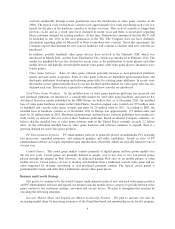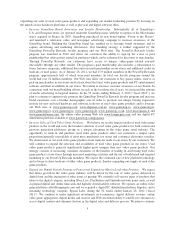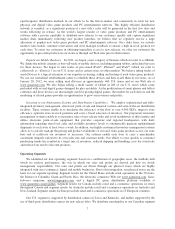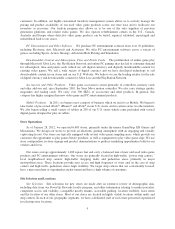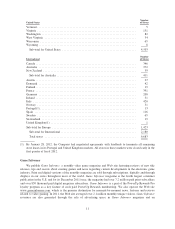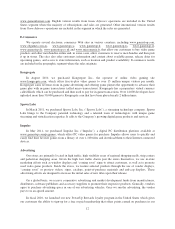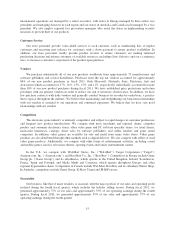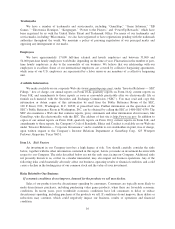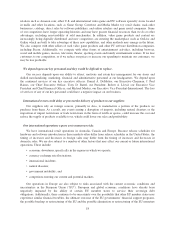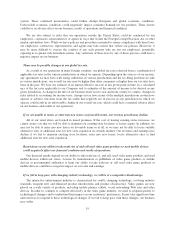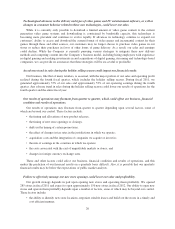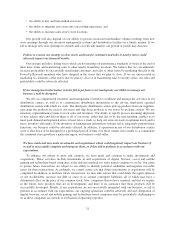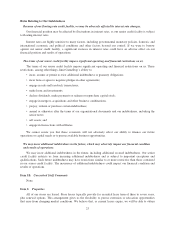GameStop 2011 Annual Report Download - page 30
Download and view the complete annual report
Please find page 30 of the 2011 GameStop annual report below. You can navigate through the pages in the report by either clicking on the pages listed below, or by using the keyword search tool below to find specific information within the annual report.Management Information Systems. Our proprietary inventory management systems and point-of-sale
technology show daily sales and in-store stock by title by store. Our systems use this data to automatically
generate replenishment shipments to each store from our distribution centers, enabling each store to carry a
merchandise assortment uniquely tailored to its own sales mix and rate of sale. Our call lists and reservation
system also provide our buying staff with information to determine order size and inventory management for
store-by-store inventory allocation. We constantly review and edit our merchandise categories with the objective
of ensuring that inventory is up-to-date and meets customer needs.
To support most of our operations, we use a large-scale, Intel-based computing environment with a
state-of-the-art storage area network and a wired and wireless corporate network installed at our U.S. and
regional headquarters, and a secure, virtual private network to access and provide services to computing assets
located in our stores, distribution centers and satellite offices and to our mobile workforce. This strategy has
proven to minimize initial outlay of capital while allowing for flexibility and growth as operations expand. To
support certain of our international operations, we use a mid-range, scalable computing environment and a
state-of-the-art storage area network. Computing assets and our mobile workforce around the globe access this
environment via a secure, virtual private network. Regional communication links exist to each of our distribution
centers and offices in international locations with connectivity to our U.S. data center as required by our
international, distributed applications.
Our in-store point-of-sale system enables us to efficiently manage in-store transactions. This proprietary
point-of-sale system has been enhanced to facilitate trade-in transactions, including automatic look-up of trade-in
prices and printing of machine-readable bar codes to facilitate in-store restocking of used video games. In
addition, our central database of all used video game products allows us to actively manage the pricing and
product availability of our used video game products across our store base and reallocate our used video game
products as necessary.
Field Management and Staff
Each of our stores employs, on average, one manager, one assistant manager and between two and ten sales
associates, many of whom are part-time employees. Each store manager is responsible for managing their
personnel and the economic performance of their store. We have cultivated a work environment that attracts
employees who are actively interested in electronic games. We seek to hire and retain employees who know and
enjoy working with our products so that they are better able to assist customers. To encourage them to sell the
full range of our products and to maximize our profitability, we provide our employees with targeted incentive
programs to drive overall sales and sales of higher margin products. In certain locations, we also provide certain
employees with the opportunity to take home and try new video games, which enables them to better discuss
those games with our customers. In addition, employees are casually dressed to encourage customer access and
increase the “game-oriented” focus of the stores.
Our stores communicate with our corporate offices daily via e-mail. This e-mail allows for better tracking of
trends in upcoming titles, competitor strategies and in-stock inventory positions. In addition, this communication
allows title selection in each store to be continuously updated and tailored to reflect the tastes and buying patterns
of the store’s local market. These communications also give field management access to relevant inventory levels
and loss prevention information. We have invested in significant management training programs for our store
managers and our district managers to enhance their business management skills. We also sponsor annual store
managers’ conferences at which we operate intense educational training programs to provide our employees with
information about the video game products that will be released by publishers in the holiday season. All video
game software publishers are invited to attend the conferences.
GameStop’s U.S. store operations are managed by a centrally-located senior vice president of stores, four
vice presidents of stores and 32 regional store operations directors. The regions are further divided into districts,
each with a district manager covering an average of 15 stores. In total, there are approximately 305 districts. Our
14


